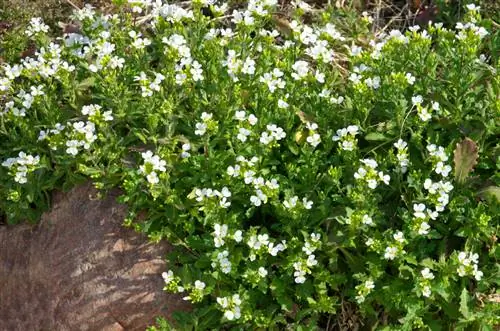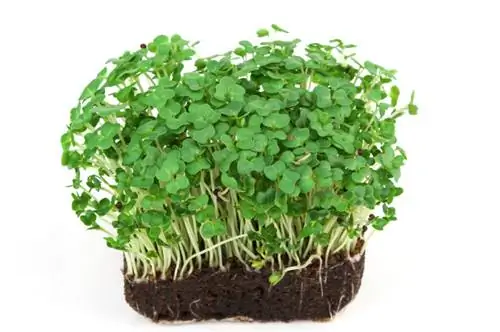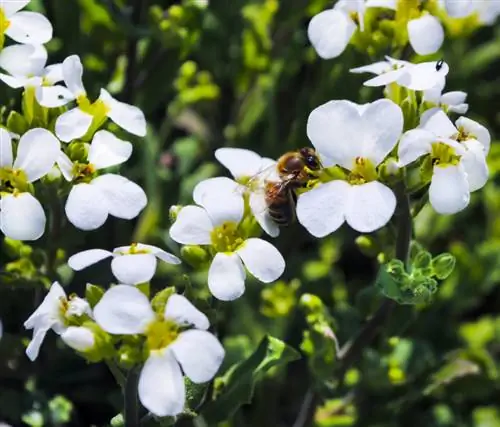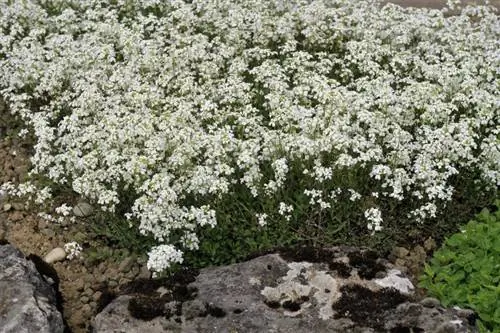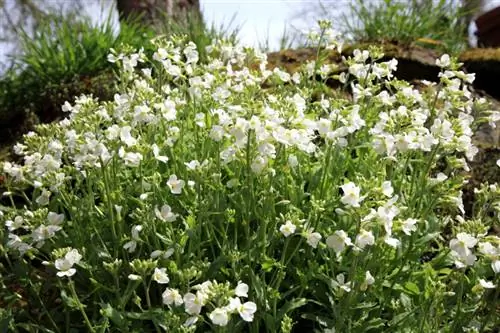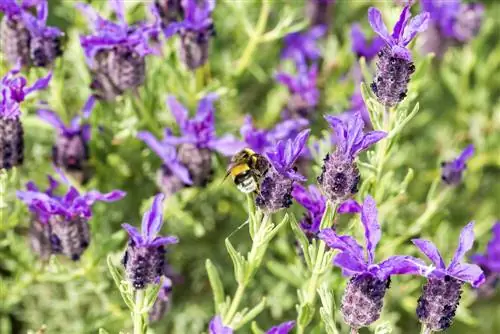- Author admin [email protected].
- Public 2023-12-25 17:45.
- Last modified 2025-01-23 11:22.
With fragrant flower clouds, goose cress covers the sunny rock garden, decorates the dry stone wall or the side of the path. In order for the white, pink or red flower mats to spread out in a compact and densely woven manner, manageable care is required. The following answers to frequently asked questions show the way through uncomplicated cultivation.
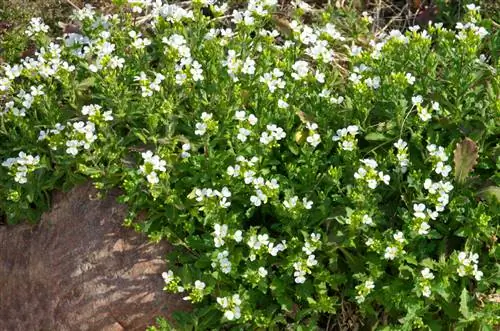
What is special about goose cress?
Goose cress is an easy-care perennial that thrives particularly in sunny rock gardens or dry stone walls. The most popular varieties are Plena, Hedi, Frühlingszauber, Variegata and Suendermannii. The flowers are edible and are suitable as decoration or as a vitamin-rich addition to salads and soups.
Planting goose cress correctly
So that the charming goose cress shows what floral power it has in its first season, we recommend planting it in early autumn. In a sunny location, create several planting holes 20-30 cm apart, as the perennial comes into its own wonderfully in small groups. Enrich the excavation with bark humus, compost and horn shavings (€52.00 on Amazon). Place a potted plant in each pit so deeply that the substrate reaches just to the bottom pair of leaves. On the day of planting itself and afterwards, an ample supply of water contributes to rapid rooting.
Care tips
The goose cress requires little care from the gardener. The nutrient supply in the bed is limited to a starter fertilization with compost and horn shavings at the end of April/beginning of May. Fertilize the pot and flower box every 4 weeks in April and May with a common liquid preparation. Since the perennial achieves its optimum in fresh, moist soil, it should not be thirsty. Always water goose cress when the soil has dried out. If the first flower floret runs out of steam, cut the withered flower stems back to the tuft of leaves to encourage further blooms. The wintergreen or evergreen foliage adorns the otherwise dreary garden during the cold season, only to be cut off close to the ground in January or February. Significant winter protection is not required for the frost-resistant perennial. We only recommend taking adequate precautions in the year of planting, in rough locations and in the planter.read more
Which location is suitable?
It's not that easy to discover flowering perennials for a full sun location. This is where the sun-loving goose cress comes in handy. Even full sunshine does not cause any problems with the abundance of flowers as long as the soil is fresh, moist, humus and well-drained. The high lime tolerance makes the spring bloomer the ideal candidate for roof gardens, stone gardens, rock steps and sunny gravesites.
What soil does the plant need?
Goose cress does not place any capricious demands on the soil. It thrives tirelessly in normal garden soil that is humus, fresh, moist and well-drained. An increased lime content in the soil is not only tolerated, but rewarded with vital growth. If the spring-fresh flower carpets thrive in the pot or balcony box, standard potting soil is sufficient.
When is flowering time?
The central flowering period of goose cress extends over the months of April and May. However, some species do not remember to follow this requirement and bloom as early as March or decorate the garden in autumn. For example, the Caucasian goose cress and the Alpine goose cress start flowering in early spring. The blue goose cress gives way to its conspecifics to put on its flower dress from July to September. Therefore, ask carefully when purchasing the plant if you have a definite flowering period in mind.read more
Cut the goose cress correctly
The pruning-friendly goose cress can be cut into shape at any time with scissors. If you cut off the withered flower stalks after the first flowering period down to the basal tuft of leaves, with a little luck you will see another flowering in late summer. You only cut these off down to the leaves, because the wintergreen or evergreen foliage creates pleasant eye-catchers in the winter garden.
The double-flowered varieties in particular are tempting to cut into vases. To do this, select the shoots with the first buds that have just opened.
Watering goose cress
Since goose cress evaporates a lot of moisture due to its abundant biomass, the normal rainfall is usually not sufficient for the water supply. Therefore, always water the bed and planter when the surface of the substrate has dried. To do this, press a finger into the soil. If the top 2 cm feel dry, you need water.
Fertilize goose cress properly
In nutrient-rich garden soil, organic boost fertilization at the end of March/beginning of April with compost, bark humus, horn shavings or guano is sufficient. Where the delicate cruciferous plant has developed dense cushions, incorporating solid fertilizer with a rake could cause damage. In this case, we recommend plant manure, such as nettle or comfrey manure, to supply the bed with nutrients. Cultivated in a balcony box or bucket, goose cress receives a dose of liquid fertilizer in April and May.
Wintering
All goose cress species that have won our gardeners' hearts are completely hardy. Explicit protection is therefore not necessary. Only in very rough locations and in planters should precautions be taken against frosty temperatures and constant winter wetness. A layer of leaves or brushwood is sufficient in the bed. Pots and balcony boxes are wrapped in bubble wrap and placed on wood. Water the perennial on mild days during dry winters, especially when frost dominates the weather.
Propagate goose cress
Has the goose cress completely convinced you with its many benefits? Then this little spring beauty can be propagated in the following way:
- Dividing the root ball in spring or autumn
- Cut cuttings during the flowering period
- Sowing the seeds directly into the bed in May
How do I transplant correctly?
Transplanting and rejuvenation go hand in hand with goose cress. If, after a few years, the flowering capacity leaves something to be desired while the perennial grows bare from the inside, proceed as follows:
- Dig up the root ball in spring or autumn
- Place on a firm surface to cut the plant with a knife or spade
- Cut out bald spots and rotten roots
Finally, plant each segment in the new location, maintaining the previous planting depth.
Is goose cress edible?
Goose cress is a feast for the senses that also tickles our taste buds. The distinctive flowers decorate cold and warm dishes, giving them the finishing touch with their fresh, spicy taste. The green leaves are also suitable for consumption. Harvested shortly before flowering, they contain plenty of vitamin C, taste spicy and round off salads or soups aromatically.read more
Beautiful varieties
- Plena: Enchantingly beautiful with white, lush double flowers and up to 25 cm long flower tendrils
- Hedi: Forms dense, pink mats of flowers over evergreen foliage; the ideal ground cover
- Spring magic: This variety decorates the rock garden with beautiful carmine-red flower carpets
- Variegata: The variety creates a picturesque look with white flowers and green-white variegated leaves
- Goose cress Suendermannii: A compact dwarf variety, excellent for bed and path borders

